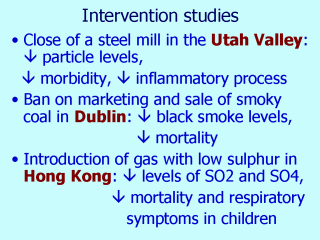| front |1 |2 |3 |4 |5 |6 |7 |8 |9 |10 |11 |12 |13 |14 |15 |16 |17 |18 |19 |20 |21 |22 |23 |24 |25 |26 |27 |28 |29 |30 |31 |32 |33 |34 |35 |review |
 |
Intervention studies Some studies illustrate the potential health benefits of policies and actions oriented to decrease the exposure to air pollution. Several years ago, Pope showed that in Utah Valley, closure of an open-earth steel mill over the winter of 1987 was associated with reductions in respiratory disease and related hospital admissions among valley residents (Pope, 1996). In a later investigation, Dye et al (2001) analysed composition of filters originally collected near the steel mill during the winter of 1986 (before closure), 1987 (during closure), and 1988 (after plant reopening). The authors found a higher quantity of sulphate and certain metals (i.e., copper, zinc, iron, lead, strontium, arsenic, manganese, nickel) in the 1986 and 1988 filters. They intratracheally instilled liquid extracts from filters to rats, finding that rats exposed to 1986 or 1988 extracts developed significant pulmonary injury and neutrophilic inflammation suggesting that sulphate or metals may be important determinants of the pulmonary toxicity observed (Dye et al., 2001). Clancy and colleagues evaluated the effect of air pollution control and death rates in Dublin (Clancy et al., 2002). After the ban, a clear reduction (70 per cent) of black smoke concentrations was observed. Subsequently, organic causes death rates decreased by 5.7 per cent, cardiovascular deaths by 10.3 per cent, and respiratory ones by 15.5 per cent, showing similar impact estimates than cohort studies. Another intervention study has focused on changes in air quality and death rates after a restriction on sulphur content in Hong Kong (Hedley et al., 2002) . The first year after intervention, both SO2 and sulphates showed a clear reduction. Two years after the restriction, SO2 maintained low levels; however, sulphate concentrations rose again and stabilised, probably, as suggested by the authors, as part of the regional pattern of sulphate pollution in southern China. Death rates showed a substantial reduction in the first 12 months, but a peak in the second winter after intervention. Considering years 3 to 5 after intervention, average annual trend decreased significantly in a 2.1 per cent for all causes, and 3.9 per cent for respiratory ones. |